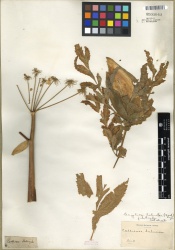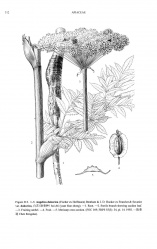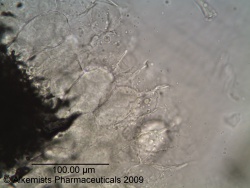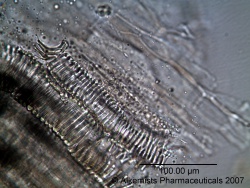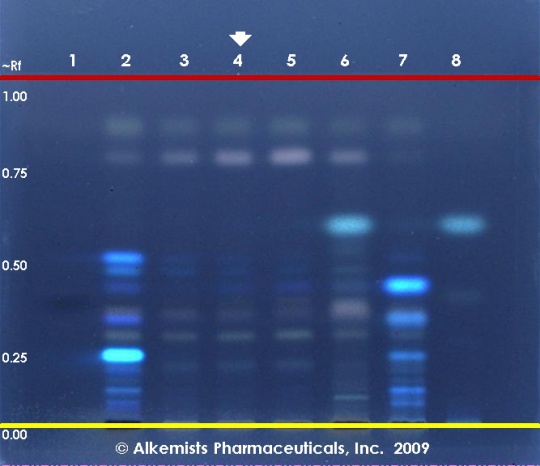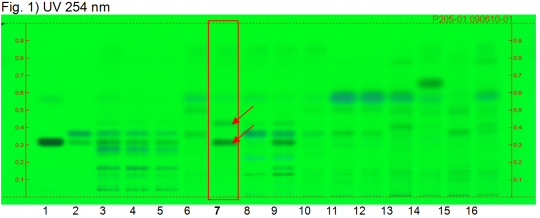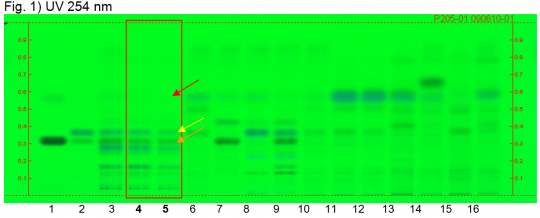Angelica dahurica (root)
Contents |
Nomenclature
Botanical Voucher Specimen
|
|
Organoleptic Characteristics
Macroscopic Characteristics
|
|
Microscopic Characteristics
 |
 |
|
|
|
High Performance Thin Layer Chromatographic Identification
|
Fragrant Angelica (root) (Angelica dahurica) Lane Assignments Lanes, from left to right (Track, Volume, Sample):
Reference materials used here have been authenticated by macroscopic, microscopic &/or TLC studies according to the reference source cited below held at Alkemists Laboratories, Costa Mesa, CA. Stationary Phase Silica gel 60, F254, 10 x 10 cm HPTLC plates Mobile Phase toluene: ethyl acetate: HCOOH [9/1/0.1] Sample Preparation Method 0.3 g + 3 ml CH3OH sonicated + heated @ 50° C ~ 1 hr Detection Method 5% Methanolic H2SO4 -> UV 365 nm Reference see Adapted from Japanese Official Monographs part III
|
|
Dahurian Angelica (root) (Angelica dahurica) Lane Assignments Lanes, from left to right (Track, Volume, Sample):
Reference Sample(s) Reference: Dissolve 1 mg each of osthole and imperatorin in 10 mL of methanol. Optional: Dissolve 1 mg of Z-ligustilide in 10 mL of methanol. Stationary Phase Stationary phase, i.e. Silica gel 60, F254 Mobile Phase Toluene, ethyl acetate, glacial acetic acid 90:10:1 (v/v/v) Sample Preparation Method Sample: Mix 1.0 g of powdered sample with 4 mL of heptane and sonicate for 5 minutes, then centrifuge and filter the solutions and use the filtrates as test solutions. Derivatization reagent: Sulfuric acid reagent; Preparation: 20 mL sulfuric acid with 180 mL methanol; Use: Dip for 1 s, heat at 100°C for 5 min Detection Method Saturated chamber; developing distance 70 mm from lower edge; relative humidity 33% Other Notes Images presented in this entry are examples and are not intended to be used as basis for setting specifications for quality control purposes. System suitability test: Imperatorin: greenish fluorescent zone at Rf ~ 0.31 (UV 366 nm); Osthole: blue fluorescent zone at Rf ~ 0.36 (UV 366 nm). Identification: Compare result with reference images. The fingerprint of the test solution is similar to that of the corresponding botanical reference sample. Additional weak zones may be present. Under UV 254 nm the chromatogram of the test solution shows a quenching zone corresponding to reference imperatorin and a quenching zone right above the position of reference osthole. There may be a faint quenching zone at the position of z-ligustilide (but no fluorescent zone). Under UV 366 nm the chromatogram of the test solution shows a greenish zone at the position of reference imperatorin, a dark blue zone at the position of reference osthole, and above it another greenish zone. A white blue fluorescent zone is seen at the position of reference Z-ligustilide at Rf ~ 0.57. After derivatization under white light there are two prominent purple zones below the solvent front. Below this zone there is a weak blue zone. At the position of imperatorin there is a greenish yellow zone and just below it a violet double zone. Test for adulteration: Under UV 254 nm no blue fluorescent zone is seen at Rf ~ 0.57 and no quenching zone is seen at the position of osthole or below the position of imperatorin. Under UV 366 nm there is no intense blue fluorescent zone below the position of imperatorin. After derivatization under white light there is no purple zone at the position of osthole (black arrow) (Angelica root, Chinese Angelica root, Doubleteeth pubescent root, Lovage root, Chinese lovage root). Source: HPTLC Association [6] |
|
Angelica (root) (Angelica archangelica) Lane Assignments Lanes, from left to right (Track, Volume, Sample):
Reference Sample(s) Reference: Dissolve 1 mg each of osthole and imperatorin in 10 mL of methanol. Optional: Dissolve 1 mg of Z-ligustilide in 10 mL of methanol. Stationary Phase Stationary phase, i.e. Silica gel 60, F254 Mobile Phase Toluene, ethyl acetate, glacial acetic acid 90:10:1 (v/v/v) Sample Preparation Method Sample: Mix 1.0 g of powdered sample with 4 mL of heptane and sonicate for 5 minutes, then centrifuge and filter the solutions and use the filtrates as test solutions. Detection Method Saturated chamber; developing distance 70 mm from lower edge; relative humidity 33% Other Notes Images presented in this entry are examples and are not intended to be used as basis for setting specifications for quality control purposes. System suitability test: Imperatorin: greenish fluorescent zone at Rf ~ 0.31 (UV 366 nm). Osthole: blue fluorescent zone at Rf ~ 0.36 (UV 366 nm). Identification: Compare result with reference images. Under UV 254 nm the chromatogram of the test solution shows quenching zones corresponding to references imperatorin and osthole (Rf ~ 0.31 and Rf ~ 0.36, orange and yellow arrow). Below these zones several quenching zones are detected. Under UV 366 nm the chromatogram of the test solution shows a dark blue fluorescent zone corresponding to the reference osthole. Right below a greenish fluorescent zone corresponding to imperatorin is detected. Below this zone several blue fluorescent zones are detected. Test for adulteration: No zone is seen at or directly below Rf ~ 0.57 (red arrow) (Chinese Angelica root, Dahurian Angelica root, Doubleteeth pubescent root, Lovage root, Chinese lovage root). Source: HPTLC Association [7] |
Supplementary Information
Sources
- ↑ MOBOT, Tropicos.org http://www.tropicos.org/Name/1701403
- ↑ MOBOT, Tropicos.org http://www.tropicos.org/Name/1701403
- ↑ Elan M. Sudberg, Alkemist Laboratories http://www.alkemist.com
- ↑ Elan M. Sudberg, Alkemist Laboratories http://www.alkemist.com
- ↑ Elan M. Sudberg, Alkemist Laboratories http://www.alkemist.com
- ↑ HPTLC Association http://www.hptlc-association.org/
- ↑ HPTLC Association http://www.hptlc-association.org/
